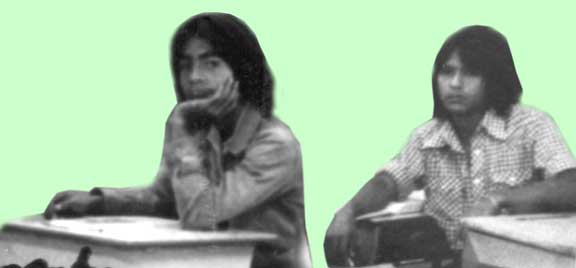|
Dakota |
|
|
|
|
|
Arnold and Raymond Lonethunder, fall of 1979, Carlyle. |
|
| FTLComm - Tisdale - March 23, 2001 | |
|
"friend" |
The Sioux were given this name by the French as they messed up the Chipawyan name for the war like Southern neighbours whom they called the "enemy" - "Natawesiwak". The people called themselves the Dakota which means "friend".(This information comes from the Ehanna Woyakapi page) |
|
|
|
|
Sioux |
In Canada we have traditionally simply referred to all the refugees from the war of extermination carried out by the post-civil war United States Army, as Sioux and we have not differentiated between the various groups who were victims in this conflict. |
|
|
|
|
Lakota |
I do not know if those who made their way into Eastern Saskatchewan and were given refugee status at the Whitebear, near Carlyle or at Carry The Kettle, near Regina were Dakotas or Lakotas. It is only my guess that these people and the others who were taken into the various Saskatchewan reservations were likely Dakota people. The reason for this speculation is that the main band came across the border and lived for a short while near Willowbunch and they were Lakota people and went back to the United States with most dying either of disease and starvation on the American reserves or, like their leaders, died in US prisons. |
|
|
|
|
Sandy |
The first Sioux person I met was the good natured pleasant Sandy Lonethunder from the Whitebear. Sandy worked with Joe Ewak at Moose Mountain provincial park and my hours spent with those two and their other companions will always live in my memory. Joe for his stories and amazing German and Sandy for his laughter. |
|
|
|
|
Whitebear |
Though I was the vice principal at the elementary school in Carlyle, I also had a bus drivers license which came in handy when we needed to take students on a field trip or attend a football game. But the downside of that license was occassionally there would be a shortage of bus drivers and I would be called up to fill in for a missing driver. It was a fall afternoon that I was assigned a truly massive seventy-two passenger machine to look after the run to return students to the Whitebear. |
|
|
|
|
warriors |
The Whitebear is a rather unusual reserve because of its mixture of people. The main controlling group on the reserve were the Saulteaux (Anicinabe) while West of the highway was the settlement of Assiniboine people (Nakota). Interspers through the reserve were a few Sioux families included two of Sandy Lonethunder's grandsons who were in my class. Both of these guys looked like warriors from a Remington painting with high cheekbones, deep set eyes and a that tall slim walk that comes from years of having to kick a few behinds to win and maintain respect. As I struggled to keep the big yellow monster of a bus between the ditches there was the usual good natured banter in the bus and one friendly grade eight student of mine sat behind me filling me in on the nature of what was going on, as well as telling me where to turn and where to stop. |
|
|
|
|
there's a |
Several times a Standingready would shout out, "there's a good one" and he would point at a stray dog and gesture to one of the Lonethunders. This happened many times and each time the bus would errupt into gails of laughter. Finally I asked my guide what the heck this was all about and he explained that the story is that Sioux, being the low life types that they are, eat dogs. These comments were just a means for the Sauteaux boys to hurl a few cheery insults at the formidable Sioux boys. |
|
|
|
|
American |
The defeat and near extinction at the hands of the United States Army was the legacy that remains with the small numbers of Dakota people who live in Canada. Because of the realisation of what the United States was doing to rid its land of aborigines, Canada granted status and accepted the Sioux into the country, although they have always been kept apart knowing that they are in fact "American Indians." |
| By Timothy W. Shire | |
